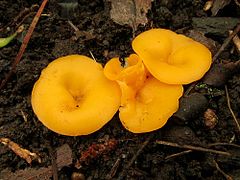Discinella terrestris
| Discinella terrestris | |
|---|---|

| |
| In Macedon Ranges, Victoria, Australia | |
| Scientific classification | |
| Kingdom: | |
| Division: | |
| Class: | |
| Order: | |
| Family: | |
| Genus: | |
| Species: | D. terrestris
|
| Binomial name | |
| Discinella terrestris | |
| Synonyms[2] | |
Discinella terrestris is a species of fungus in the family Helotiaceae. It was first described as Helotium terrestre by Miles Joseph Berkeley and Christopher Edmund Broome in 1882, from collections made in Brisbane.[3] R.W.G. Dennis transferred it to the genus Discinella in 1958.[4]
Fruit bodies are orange to yellowish-orange discs up to 10 mm (0.4 in) in diameter.[5] The cylindrical eight-spored asci are borne on long stalks, and measure 200–225 by 10–14 μm; spores are elliptical to spindle-shaped, contains two to four oil droplets, and measure 14–25 by 7.5–9 μm. Paraphyses are shaped like narrow cylinders about 2 μm thick, and have rounded tips. The species is found in Australia, where it grows on the floor of sclerophyllous eucalypt forests.[6]
References
- ^ Saccardo PA. (1889). "Discomyceteae et Phymatosphaeriaceae". Sylloge Fungorum. 8: 468.
- ^ "Discinella terrestris (Berk. & Broome) Dennis :342, 1958". MycoBank. International Mycological Association. Retrieved 2013-01-12.
- ^ Berkeley MJ, Broome CE. (1883). "List of fungi from Brisbane, Queensland; with descriptions of new species. Part II". Transactions of the Linnaean Society of London. 2 (3): 53–73. doi:10.1111/j.1095-8339.1883.tb00004.x.
- ^ Dennis RWG. (1958). "Critical notes on some Australian Helotiales and Ostropales". Kew Bulletin. 13 (2): 321–58. doi:10.2307/4109542. JSTOR 4109542.
- ^ Fuhrer BA. (2005). A Field Guide to Australian Fungi. Bloomings Books Pty Limited. p. 315. ISBN 978-1-876473-51-8.
- ^ Capdevila-Argüelles L, Zilletti B. (2005). Issues in Bioinvasion Science. Springer. p. 8. ISBN 978-1-4020-3870-9.
